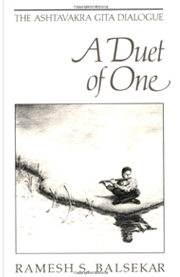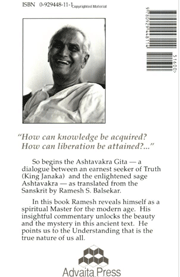| Title |
A Duet of One
(The Ashtavakra Gita Dialogue) |
  |
| Author |
Ramesh S. Balsekar |
| ISBN |
818807160-9 |
| Publishing Date |
2010 (Indian edition) |
| Publisher |
Zen Publications |
| Pages |
215 |
| Language |
English |
| Price |
Rs. 300 (India only) |
According to a popular belief, when Narendranath (Vivekananda) came to Ramakrishna, he had a strong rational bent of mind and demanded proof for everything. Ramakrishna looked at him and realized that he was carrying a great potential within him, but it was limited by his logical mind. Ramakrishna said, "I have become a little old and have difficulty reading, so please read me from the book lying there." Naren agreed to read but no sooner had he read a few sutras than he started feeling a tremendous upheaval. He wanted to stop but Ramakrishna insisted that he continued reading. It is said that Naren kept on reading aloud from the book and ascended into Awareness. The book was the Ashtavakra Gita.
A Duet of One is a rendition of the Ashtavakra Gita in English by Ramesh S. Balsekar (1917 - 2009). Ramesh worked in an Indian nationalized bank and retired as its President in 1977. After his retirement, Ramesh met his Guru, Sri Nisargadatta Maharaj, the well-known Advaita master. Following a command from his master, Ramesh himself began teaching in 1982 and wrote more than 25 books. Ramesh was regarded as a contemporary sage and a householder Guru.
The Ashtavakra Gita is a dialogue between a realized master and a ripe student. What makes it distinct from all the other spiritual texts is the amazing clarity and directness of its message and delivery. Unfortunately, these very attributes have also been the reasons for its lack of popularity. As Ramesh puts it
“(Ashtavakra Gita) is so specifically clear and unambiguous that it does not lend itself to the twists and turns required by commentators to justify their own philosophical pre-possessions or spiritual leanings.”
A Duet of One is one of the few insightful modern commentaries on Ashtavakra Gita available today.
Ramesh has preferred to render the verses in his own words in English, over the traditional approach of word-to-word translation from Sanskrit. The rendition is inspired and elegant, and the language flows effortlessly. Ramesh also plays the role of a guide; pausing in his commentary ever so often, to highlight a context, or explain the thought process of the guru or the disciple, or share the words of another master.
Ramesh prefaces the book with an explanation of why our scriptures carry repetition of the same fact or statement in different ways. Ramesh says, “…
a certain statement will have a sudden impact on a particular person on a particular moment, even though the statement may have been repeated several times earlier.” In Ashtavakra Gita too there is considerable amount of repetition. Perhaps the guru taps the nail again and again to make sure it is firmly in place. Ramesh also reminds us of a fundamental lesson: “
It is important to listen to every statement of the guru as a fresh lesson, and not to ignore it as a mere repetition”.
The book opens with a brief account of how Ashtavakra came about to be known as the ‘one with eight curves’ and the circumstances of his meeting with King Janaka. Ashtavakra was only a 12-year old child at the time, but his inner light was perceived by Janaka who requested Ashtavakra to accept him as a disciple. A great example of a seeker looking beyond the physical appearance of the guru.
The dialogue begins with a set of direct questions from Janaka on knowledge, liberation and renunciation. These questions set the environment for the rest of the dialogue. Ramesh observes: “
The very first question of the disciple is intensely significant for the guru. It tells him the general level and conditioning of the disciple….that is what interests the guru because on that will depend the guru’s answers and advice.” Nineteen verses that follow carry direct and authoritative statements from Ashtavakra which, without preliminaries, cut right through to the heart of his teaching. Ashtavakra’s statements are a deliberate attempt to provoke a response from Janaka. It needs to be mentioned here that in addition to the powerful lessons in non-duality, the book also provides a wonderful study of the dynamics of
guru-shishya relationship. One gets to observe from close range, how a sage of Ashtavakra’s spiritual stature observes his disciple’s questions and reactions, and how he acknowledges, encourages, provokes and tests the disciple. At every important turn, Ramesh gives us an account of the changing chemistry of the relationship between Ashtavakra and Janaka.
In response to the powerful statements from his guru, Janaka looks within, contemplates and speaks of his deepening understanding and the growing experience of self-realisation. Ashtavakra observes carefully and wants Janaka to test himself to see if the knowledge is being applied to the challenges of daily living and also check if Janaka has faced the fact that he does not and cannot exist as a separate entity. Ramesh says, “
Ashtavakra becomes the devil’s advocate in order to find out if the disciple has truly understood his teaching in all its subtleties and apparent contradictions.” In the fourteen verses that follow, Ashtavakra throws a series of suggestions and scenarios at Janaka. Ramesh explains, “
In all these suggestions, there is a veiled element of doing something so that Janaka may acquire enlightenment, and Ashtavakra is anxiously waiting for Janaka’s reactions to these cunning suggestions.” Much to his guru’s pleasure, Janaka remains firmly rooted in his understanding. His reaction is not only appropriate but also spontaneous and free of anxiety.
Assured by Janaka’s response, Ashtavakra then expands on the themes of bondage, annihilation of the ‘pairs of opposites’, need for dispassion, shunning desires and ‘non-volitional living’. Janaka listens to his guru and in turn, describes the impact the words have on the state of his mind and the transformation that spreads within him. By now Janaka’s questions and Ashtavakra’s doubts have subsided and the dialogue has progressed to a state of reverberation between Consciousness and Consciousness “
sharing the state of fulfilment”. Janaka goes on to describe his new found understanding of the condition of a
Jnani who goes about his business in daily life and remains unaffected by the world around him.
Ashtavakra is pleased with Janaka’s transformation and proceeds to deliver some of his most significant messages: “
The person with a keen intellect becomes enlightened even when the instruction is imparted casually, whereas without it the immature seeker continues to remain confused even after a lifetime of seeking” and“
all there is, is Consciousness”. Ashtavakra leads his disciple deeper into the waters with the words: “
Enlightenment or Self-abidance is our natural state.
It does not need to be acquired. Any personal, volitional effort means only strengthening the ego, ‘the me’ which is itself the obstruction that covers and hides our original state.
”
The dialogue is a beautiful illustration of the process of
shravana (listening) leading to
manana (meditating on what is listened to) and finally,
nididhyasana (letting knowledge settle down from intellectual level to intuitive level). Ashtavakra goes on to reinforce Janaka’s understanding with a final reiteration of his teachings. Janaka continues to absorb and as the result, experiences transcendence. He bursts forth in what could be described as a song of exuberance. Janaka sings of his freedom and of mutual annihilation of the ‘
opposites created by his earlier conditioning’. It is an eloquent description of the state of a
Jnani. The duality is transcended and the deep eternal silence is reached. In Ramesh’s words, “
The result is healing the split-mind into wholeness which is called enlightenment. It is the return from the personal to the impersonal, from the individual to the universal.”
The Ashtavakra Gita is a bold and potent exposition of the Truth.
A Duet of One is an honest and accessible rendition of this extraordinary song of Ashtavakra. It is a voyage worth going on, with Ramesh Balsekar as the navigator.